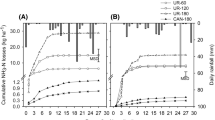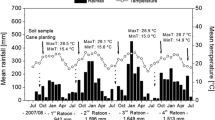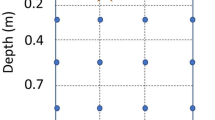Abstract
Fertigation can be a more efficient means of applying crop nutrients, particularly nitrogen (N), so that nutrient application rates can be reduced in fertigated crops. However, there is little information on the extent of the possible reduction in N application rate for fertigated sugarcane, one of the major row crops grown under trickle irrigation, nor the fate of N in fertigated sugarcane systems if N application rates are not reduced. An experiment was established to determine the response of cane and sugar production to different N rates (0–240 kg ha−1 year−1) spanning that recommended for conventional irrigation systems (160 kg ha−1 year−1). As well as yield, N removed in the crop and changes in soil mineral N were determined annually for four crops (a plant and three ratoon crops). δ15N values were also measured in selected treatments at selected times to assess possible N inputs to the experiment via biological N fixation (BFN). Yields of cane and sugar responded to application of N fertiliser in the three ratoon crops, but they were not significantly increased by applying more than 80 kg ha−1 of N. There were no N responses in the plant crop, as there was >200 kg ha−1 of soil mineral N (SMN) to 2 m depth at the site prior to planting, and much of this SMN was depleted in the treatment receiving no N. There was no evidence of N input from BFN in the experiment. During the 4-year study period, net removal of N from the treatment with no applied N totalled 207 kg ha−1. When 80 or 120 kg ha−1 year−1 of N was applied to ratoon crops, outputs of N from the harvested crop approximately balanced inputs from fertiliser and depletion of SMN during the experiment. Inputs clearly exceeded output at higher N application rates. Assuming that the net removal of N from the treatment with no applied N was the same as the net mineralisation of N from soil organic matter in all treatments in the experiment, 204–639 kg ha−1 of N was unaccounted for in the treatments with applied N over the duration of the experiment. While some of this N (e.g. 45 kg ha−1) may have resulted in small (and undetectable) increases in total soil N, much of it would have been lost to the environment. We suggest that the high soil water contents maintained with daily application of irrigation water through the trickle system promotes mineralisation of soil organic matter and hence losses of N to the environment. Thus, particular care is required to avoid over-application of N in fertigated sugarcane.





Similar content being viewed by others
References
Bar-Yosef B (1999) Advances in fertigation. Adv Agron 65:1
Barrie A, Brookes ST, Prosser SJ, Debney S (1995) High productivity analysis of 15N and 13C in soil/plant research. Fert Res 42:43
Biggs IM, Stewart GR, Wilson JR, Critchley C (2002) 15N natural abundance studies in Australian commercial sugarcane. Plant Soil 238:21–30
Boddey RM, Polidoro JC, Resende AS, Alves BJR, Urquiaga S (2001) Use of the N-15 natural abundance technique for the quantification of the contribution of N-2 fixation to sugar cane and other grasses. Aust J Plant Physiol 28:889
Calcino DV (1994) Australian sugarcane nutrition manual. BSES/SRDC, Brisbane, Australia
Catchpoole VR, Keating BA (1995) Sugarcane yield and nitrogen uptake in relation to profiles of mineral-nitrogen on the soil. Proc Aust Soc Sugar Cane Technol 17:187
Dart IK, Baillie CP (1997) Wetting patterns surrounding drip tape emitters in sandy soil. Proc Aust Soc Sugar Cane Technol 19:505
Dart IK, Baillie CP, Thorburn PJ (2000) Assessing nitrogen application rates for subsurface trickle-irrigated cane at Bundaberg. Proc Aust Soc Sugar Cane Technol 22:230
Freney JR, Denmead OT, Saffigna PG, Wood AW, Chapman LS, Hurney AP (1991) Ammonia loss from sugar cane fields as affected by fertiliser placement, irrigation and canopy development. Proc Aust Soc Sugar Cane Technol 13:38
Haynes RJ (1985) Principles of fertiliser use in trickle-irrigated crops. Fert Res 6:235
Henzell EF, Vallis I, Lindquist JK (1968) Automatic colorimetric methods for the determination of nitrogen in digests and extracts of soil. Transactions of the 9th international congress on soil science. Adelaide, p 513
Keating BA, Verburg K, Huth NI, Robertson MJ (1997) Nitrogen management in intensive agriculture: sugarcane in Australia. In: Keating BA, Wilson JR (eds) Intensive sugarcane production: meeting the challenge beyond 2000, CAB International, Wallingford, UK, p 221
Keating BA, Kingston G, Wood AW, Berding N (1999a) Monitoring nitrogen at the mill to guide N fertilisation practice on farm. Proc Aust Soc Sugar Cane Technol 21:10
Keating BA, Robertson MJ, Muchow RC, Huth NI (1999b) Modeling sugarcane production systems. 1. Development and performance of the sugarcane module. Field Crops Res 61:253
Meyer WS (1997) The irrigation experience in Australia: lessons for the sugar industry. In: Keating BA, Wilson JR (eds) Intensive sugarcane production: meeting the challenge beyond 2000, CAB International, Wallingford, UK, p 437
Moore S, Stein WH (1954) A modified ninhydrin reagent for the photometric determination of amino acids and related compounds. J Biological Chem 211:907
Muchow RC, Robertson MJ, Wood AW, Keating BA (1996) Effect of nitrogen on the time-course of sucrose accumulation in sugarcane. Field Crops Res 47:143
Muthukumarasamy R, Revathi G, Lakshminarasimhan C (1999) Influence of N fertilisation on the isolation of Acetobacter diazotrophicus and Herbaspirillum spp. from Indian sugarcane varieties. Biol Fert Soil 29:157
Ng Kee Kwong KF, Deville J (1994) Application of 15N-labelled urea to sugar cane through a drip-irrigation system in Mauritius. Fert Res 39:223
Ng Kee Kwong KF, Umrit G, Deville J (1996) Nitrogen fertilization of sugarcane in an intercropping system with maize and potato in the humid tropical climate of Mauritius. Exp Agric 32(2):213–218
Ng Kee Kwong KF, Paul JP, Deville J (1999) Drip-fertigation: a means for reducing fertilizer nitrogen to sugarcane. Exp Agric 35:31
Rayment GE, Higginson FR (1992) Australian laboratory handbook of soil and water chemical methods. Inkata Press, Melbourne
Reuter DJ, Robinson JB, Peverill KI, Price GH, Lambert MJ (1997) Guidelines for collecting, handling and analysing plant material. In: Reuter DJ, Robinson JB (eds) Plant analysis: an interpretation manual (2nd edn). CSIRO Publishing, Collingwood, Victoria, Australia, p 53
Ridge DR, Hewson SA (1995) Drip irrigation management strategies. Proc Aust Soc Sugar Cane Technol 17:8
Robertson FA, Thorburn PJ (2001) Crop residue effects on soil C and N cycling under sugarcane. In: Rees RM, Ball BC, Campbell CD, Watson CA (eds) Sustainable management of soil organic matter, CAB International, Wallingford, UK, p 112
Stanley CD, Green RE, Khan MA, Santo LT (1990) Nitrogen-fertilization rate and soil nitrate distribution for microirrigated sugarcane. Soil Sci Soc Am J 54:217
Thomas MR, Muchow RC, Wood AW, Spillman MF, Robertson MJ (1993) Field techniques to quantify the yield-determining processes in sugarcane. II. Sampling strategy analysis. Proc Aust Soc Sugar Cane Technol 15:344
Thorburn PJ, Sweeney CA, Bristow KL (1998) Production and environmental benefits of trickle irrigation for sugarcane: a review. Proc Aust Soc Sugar Cane Technol 20:118
Thorburn PJ, Keating BA, Robertson FA, Wood AW (2000) Changes in soil carbon and nitrogen under trash blanketing. Proc Aust Soc Sugar Cane Technol 22:217
Thorburn PJ, Biggs JS, Weier KL, Keating BA (2003) Nitrate in groundwaters of intensive agricultural areas in coastal Northeastern Australia. Agric Ecosyst Environ 94:49–58
Vallis I, Catchpoole VR, Hughes RM, Myers RL, Ridge DR (1996) Recovery in plants and soils of 15N applied as subsurface bands of urea to sugarcane. Aust J Agric Res 47:355
Verburg K, Keating BA, Probert ME, Bristow KL, Huth NI (1998) Nitrate leaching under sugarcane: interactions between crop yield, soil type and management strategies. In: Michalk DL, Pratley JE (eds) Agronomy: growing greener future. Proceedings of the 9th Australian Society of Agronomy Conference, Wagga Wagga, NSW, 20–23 July. Australian Society of Agronomy, Wagga Wagga, p 717
Weier KL, McEwan CW, Vallis I, Catchpoole VR, Myers JR (1996) Potential for biological denitrification of fertiliser N in sugarcane soils. Aust J Agric Res 47:67
Wiedenfeld RP (1995) Effects of irrigation and N fertilizer application on sugarcane yield and quality. Field Crops Res 43:101
Yoneyamma T (1996) Characterization of natural 15N abundance of soils. In: Boutton TW, Yamasaki S (eds) Mass spectrometry of soils. Dekker, New York, p 205
Acknowledgements
The assistance of Bundaberg Sugar field and laboratory employees as well as Mr. Damien Mazzucchelli, formally of CSIRO, is gratefully acknowledged. This work was supported by Land and Water Australia.
Author information
Authors and Affiliations
Corresponding author
Additional information
Communicated by K. Bristow
Rights and permissions
About this article
Cite this article
Thorburn, P.J., Dart, I.K., Biggs, I.M. et al. The fate of nitrogen applied to sugarcane by trickle irrigation. Irrig Sci 22, 201–209 (2003). https://doi.org/10.1007/s00271-003-0086-2
Received:
Accepted:
Published:
Issue Date:
DOI: https://doi.org/10.1007/s00271-003-0086-2




